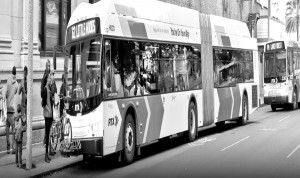RTA hopes to build a New Orleans East Transit Center
26th February 2018 · 0 Comments
By Susan Buchanan
Contributing Writer
Buses to and from New Orleans East are often crowded and sometimes late. The New Orleans Regional Transit Authority wants to remedy the situation with a new hub and service changes, including more express offerings. It hopes to build a New Orleans East Transit Center and is waiting to hear about an application submitted last fall for a grant from the U.S. Department of Transportation.
The RTA should know soon. According to DOT last week, “the TIGER discretionary grant process is ongoing, and announcements about grant recipients will be made in the coming weeks.”
TIGER stands for Transporta-tion Investment Generating Economic Recovery and is a competitive program for projects in communities across the country. DOT’s Federal Transit Admini-stration helps grant recipients get the technical assistance they need to complete their projects.
On October 16, the RTA submitted a proposal asking for about $6 million in federal money, with a local match of $2 million to come from sales taxes. The new transit center would contain bays serving existing bus lines and new express lines. “It would be built along the Bullard Avenue corridor near the interchange with I-10, within easy access to the new Walmart,” said Transdev spokeswoman Taslin Alfonzo, serving the Regional Transit Authority. Walmart opened on Bullard in 2014.
But don’t expect a new transit center right away. Under the RTA’s long-term Strategic Mobility Plan, adopted in December, studies for centers for New Orleans East, downtown and Algiers, along with several smaller hubs, will be completed by the end of a 2018-2022 phase. Plans are to build the New Orleans East and Algiers transit centers within the years 2023 to 2027.
Alfonzo said the following routes would end or connect at the proposed center: The number 60 Hayne- from Hayne Boulevard at Vincent to Orleans Avenue at City Park; the 62 Morrison Express- from Bullard Avenue at Walmart to Elk Place at Canal; the 63 New Orleans East Owl- from New Orleans East to Downman Road and from Canal Street to the New Orleans East Walmart; the 64 Lake Forest Express- from Michoud Boulevard at Expedition to Elk Place at Canal Street; the 65 Read-Crowder Express- from Michoud at Expedition to Elk Place at Canal.
Proposed, new bus routes connecting with the transit center would include the 67 Express, traveling along I-10 to the Chef Highway exit and then heading westbound on Chef to a stop at or near the Gentilly Woods Mall, before re-entering I-10 to go to downtown New Orleans.
Another prospective route from the transit center is the 68 Express, with details to be determined, Alfonzo said. The existing 94 Broad would also connect with the center, with plans to add a 94A Broad, from Michoud at Chef Menteur Highway to Washington at South Broad, and a 94B Broad with limited stops from Michoud at Chef Menteur to Washington at South Broad.
“But these proposed routes will move forward only if we get the funding,” Alfonzo said. And before they’re confirmed, routes to and from the transit center will require a full analysis.
Last year, 3.04 million RTA rides were taken to and from New Orleans East, up nearly five percent from 2016, Alfonzo said. Starting in 2010, new articulated or accordion buses, carrying more passengers, were introduced on the heaviest routes.
Alex Posorske, executive director of advocacy group RIDE New Orleans, said bus service to the East improved in 2016, but passengers have increased and buses remain crowded—especially during rush hours for students and commuters. Sometimes it’s standing room only, and the trips are long. “If arteries in the East are snarled with traffic or the I-10’s backed up, buses get behind schedule,” he said.
Posorske, like the RTA, believes that a new transit center needs to include local buses connecting there with express service to take passengers right into town.
Regarding car ownership, the East is in line with the 19 percent of Orleans Parish households that don’t have access to an auto, he said. The East’s over 80,000 residents include all income levels, with some families owning several cars and others none.
The RTA aims to reduce commuting times in the East and across the city over the next ten years, according to its Strategic Mobility Plan. During peak travel times last year, only 30 percent of jobs in Orleans and Jefferson could be reached on public transit by members of average households in the RTA’s service area within an hour. That means most RTA commuters spent over an hour just to get to work.
To shorten travel time, the RTA wants to upgrade several existing routes, including its Broad-Gentilly-Chef Menteur trip, to High Capacity Transit corridors. Other highly traveled corridors are the Canal Street and St. Charles Avenue streetcars and Tulane Avenue’s buses. The RTA’s efforts to make transit faster on these HCT lines should be completed in 2023 to 2027.
The RTA aims to increase on-time performance for its fixed routes from about 75 percent in 2017 to 80 percent in 2020 and 85 percent in 2022.
As for the East’s transit hub, what if TIGER funds for it are denied? “We don’t have any other monies to help build the center at this time,” Alfonzo said.
Recent TIGER grants to New Orleans include a $10 million award in 2015 to replace the Canal Street ferry terminal. In fiscal 2010, DOT supplied $45 million to build the Loyola Avenue-Union Passenger Terminal streetcar line. But work on the next streetcar leg, running up North Rampart to Elysian Fields, had to be funded with proceeds from a local bond sale in 2010. The RTA’s applications for TIGER grants to extend the streetcar up St. Claude were denied in 2011 and 2012.
This article originally published in the February 26, 2018 print edition of The Louisiana Weekly newspaper.




